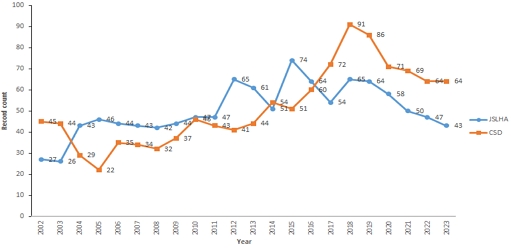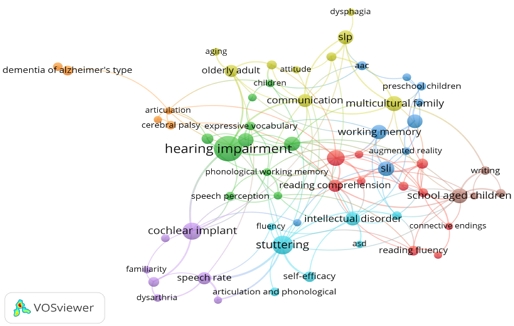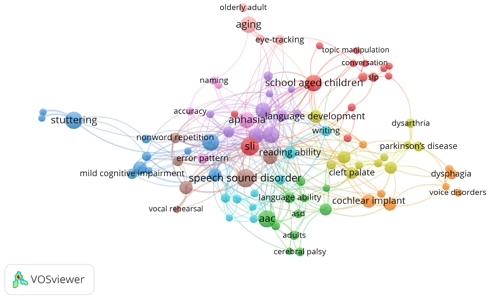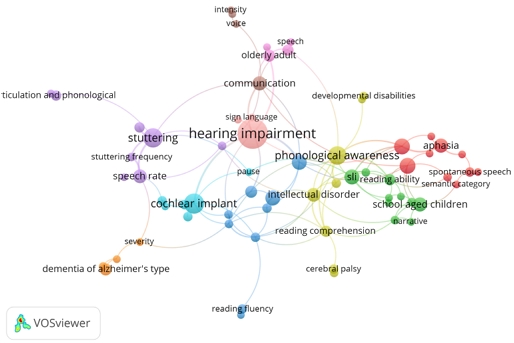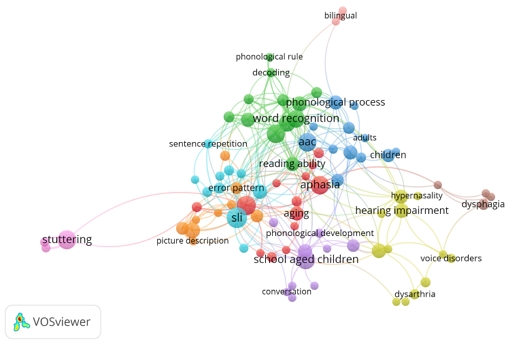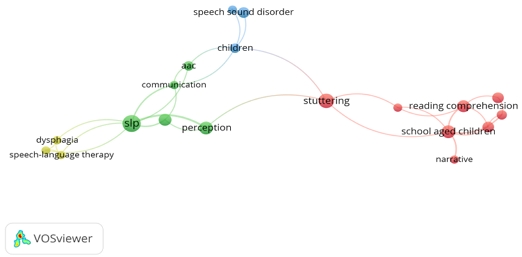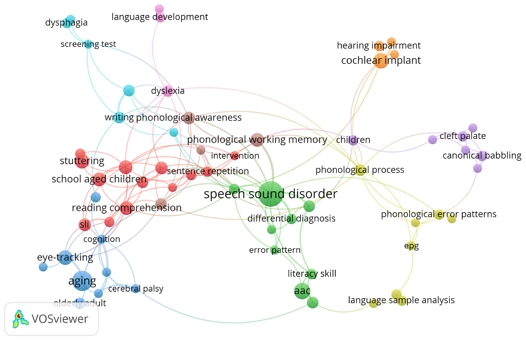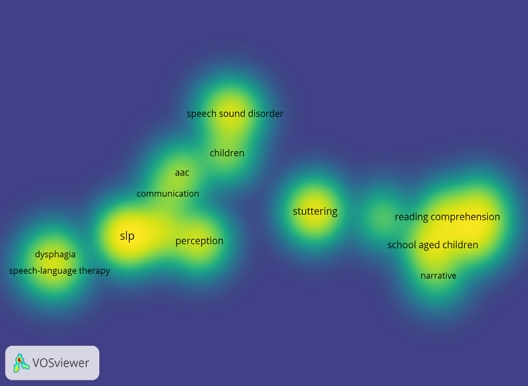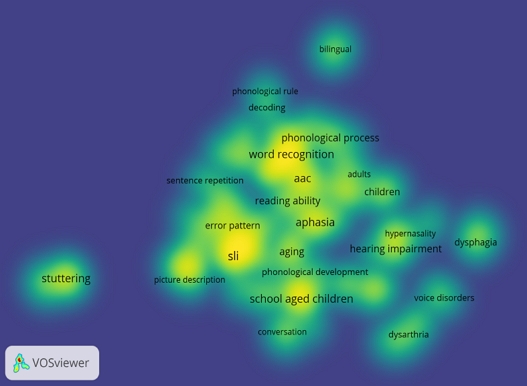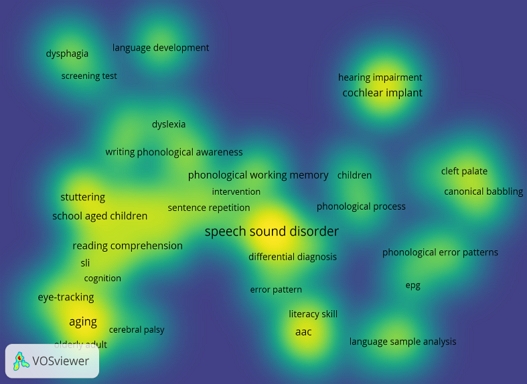
2002-2023년 국내 언어재활 분야의 계량서지학적 연구 동향 분석: 『언어치료연구』 대 『언어청각장애연구』
Copyright 2024 ⓒ Korean Speech-Language & Hearing Association.
This is an Open-Access article distributed under the terms of the Creative Commons Attribution Non-Commercial License (http://creativecommons.org/licenses/by-nc/4.0) which permits unrestricted non-commercial use, distribution, and reproduction in any medium, provided the original work is properly cited.
초록
본 연구의 목적은 2002년부터 2023년까지 ‘언어치료연구(JSLHD)’와 ‘언어청각장애연구(CSD)’에 게재된 논문을 계량서지학적으로 분석하여, 연구 경향을 알아보고 향후 언어치료 분야의 연구 활성화에 이바지하는 것이다.
JSLHD와 CSD에서 2002년부터 2023년까지 게재된 각각 1,105편과 1,134편의 논문을 Web of Science(WoS) 데이터베이스에서 서지정보를 추출하였다. 추출된 서지정보는 VOSviewer를 이용하여 계량서지학적으로 키워드 네트워크 분석을 시행하였다. WoS에서 검색 장소(search in)를 ‘KCI-Korean Journal Database’로, 학술지 이름(publication titles)을 각각 ‘언어치료연구’와 ‘Communication Sciences & Disorders’로 검색하였다. 최종적으로 선택된 정보를 연도별로 ‘내보내기’를 하였다. 수집한 서지정보를 VOSviewer를 사용하여 키워드의 동시-출현빈도를 분석하고 그 결과를 시각화하였다.
언어치료 영역에서 다양한 키워드와 연구 주제가 시도되었으며, JSLHD와 CSD 모두 2018년까지는 증가 추세였으나, 2019년부터는 감소 주체를 보였다. JSLHD는 ‘hearing impairment’, ‘stuttering’, ‘cochlear implant’, ‘phonological awareness’, ‘multicultural families’의 순이었고, CSD는 ‘speech sound disorder’, ‘SLI’, ‘AAC’, ‘stuttering’, ‘working memory’ 순으로 출현빈도가 높게 나타났다. JSLHD는 ‘perception’, ‘speech sound disorder’, ‘SLP’, ‘children’, ‘morphological awareness’, ‘AR’이 최근에 출현하였고, CSD는 ‘eye-tracking’, ‘speech sound disorder’, ‘morphological awareness’, ‘olderly adult’, ‘receptive vocabulary’의 순으로 평균 출판 연도가 나타났다.
JSLHD와 CSD 모두 언어치료 분야의 학문적 발전에 이바지한 것을 확인할 수 있었다. 본 연구를 계기로 양 학술지의 통합적인 지식구조와 현재 상황을 평가하고 부족한 연구 영역에 대한 보완이 이뤄져야 할 것이다.
Abstract
The purpose of this study is to analyze the research trends through a bibliometric analysis of papers published in the Journal of Speech-Language & Hearing Disorders (JSLHD) and Communication Sciences & Disorders (CSD) from 2002 to 2023, aiming to contribute to the activation of future research in speech-language pathology.
Bibliometric information was extracted from 1,105 papers from JSLHD and 1,134 papers from CSD, published between 2002 and 2023, using the Web of Science (WoS) database. This information was then used to conduct a keyword network analysis with VOSviewer. The KCI-Korean Journal Database was searched for the publication titles, “Journal of Speech-Language & Hearing Disorders” and “Communication Sciences & Disorders”. The results were exported by year. The collected bibliographic data were analyzed and visualized for keyword co-occurrence using VOSviewer.
In the field of speech therapy, various keywords and research topics have been explored. Both JSLHD and CSD showed an increasing trend until 2018, but from 2019 onwards, they exhibited a decreasing trend. For JSLHD, the terms ‘hearing impairment’, ‘stuttering’, ‘cochlear implant’, ‘phonological awareness’, and ‘multicultural families’ appeared in that order of frequency. For CSD, the terms ‘speech sound disorder’, ‘SLI’, ‘AAC’, ‘stuttering’, and ‘working memory’ appeared in that order of frequency.
Both JSLHD and CSD have contributed to the academic advancement in speech-language pathology. Through this study, it is necessary to evaluate the integrated knowledge structure and the current situation of both journals, and to supplement the areas of research that are lacking.
Keywords:
VOSviewer, keyword co-occurrence analysis, JSLHD, CSD, bibliometric analysis키워드:
키워드 동시-출현빈도 분석, 계량서지학적 분석Ⅰ. 서론
1918년 남대문 소학교에서 말더듬 아동 치료 교실이 개최되었다는 것이 한국의 언어치료에 대한 최초의 기록이다(Kwon et al., 2013). 1969년 1월 국내 최초로 언어치료실이 연세의료원 이비인후과에 설치된 이후 1960년대와 1970년대는 언어치료와 청각학에 대한 강의가 특수교육과에서 산발적으로 이루어졌다(Lee, 1999). 언어치료학에 관한 우리나라 대학 교육의 첫걸음은 대구대학교 재활과학대학 언어치료학과에서 1987년 학과개설 인가를 받고, 1988년 처음으로 신입생을 받은 것이다(Kwon, 2010).
1986년 2월 22일에 한국언어병리학회, 1990년 5월 12일에 한국언어치료학회가 각각 창립되었다. 이후 한국언어병리학회는 1998년 9월 19일 한국언어청각임상학회로 이름을 바꾸었다(Lee, 1999). 한국언어치료학회는 1991년 ‘언어치료연구(Journal of Speech-Language & Hearing Disorders: JSLHD)’를 발행한 이후 1998년부터 2003년까지는 매년 2호씩, 2004년부터 현재까지는 매년 4호씩 학술지를 발행해 왔다(Park, 2017). 한국언어청각임상학회는 1996년 ‘언어청각장애연구(Korean Journal of Communication Disorders)’를 창간하였고, 이후 ‘Communication Sciences & Disorders(CSD)’로 이름을 변경하였다(Lee, 1999; Pyo, 2013). 발간 이후 CSD는 2004년 1월에, JSLHD는 2006년 1월에 한국연구재단의 한국학술지인용색인(Korea Citation Index: KCI)에 각각 등재되었다. 양 학술지는 언어치료 교육 및 연구 활동이 이루어지는 계기가 되었고, 현재까지 언어치료학의 학문적 발전을 이끌어 왔다. 초기에는 기초연구와 실험연구가 주를 이루었다면, 최근에는 특정 주제에서 벗어나서 다양한 영역에서 심층적인 연구가 이루어지고 있다(Park, 2017; Pyo, 2013).
일정 기간 동안 출간된 문헌을 분석하여 특정 분야의 연구 동향을 살펴보는 것은 현재까지 해당 분야의 지식과 이론을 파악하고 관리하는 데 효과적이다(Cooper & Hedges, 1994). 메타 연구(meta research)는 연구 주제, 연구 분야 및 연구 방법 등 기존 연구 결과를 종합ㆍ고찰하여 앞으로의 연구에 대한 방향을 제공한다(Kim et al., 2015). 따라서 다양한 문헌 연구와 메타 연구가 이뤄져 왔다. 그러나 이러한 분석 방법은 선정되는 분석 기준과 방법에 따라서 선정되는 논문들이 달라져서, 연구자의 관점과 생각에 따라 해석이 달라질 수 있고, 주관성이 개입될 여지가 많다(Cho, 2011; Jeong, 2019). 또한 연구 주제나 내용 사이의 관계성을 알아보기 어렵다(Cho & Cho, 2017). 연구자가 임의로 만든 항목을 이용한 전통적 내용 분석 방식의 타당성 문제에서 벗어나고(Danowski, 1993), 이러한 한계점을 보완하며 주관적 개입을 통제하고 객관성을 높이기 위해 최근에는 계량서지학적 분석 방법을 활용하고 있다(Kim & Choi, 2024; Park, 2017; Pyo, 2013; Vitevitch, 2023). 계량서지학적 분석은 수학, 통계 도구를 이용하여 많은 수의 서지정보 데이터를 정량적으로 분석하여 준다(van Eck & Waltman, 2010). 이를 통해 논문의 출간 연도, 인용 횟수, 저자, 기관, 국가, 키워드 등을 분석하여, 연구의 주요 분야와 핵심 연구 결과를 이해하고 연구의 흐름을 파악하는 데 도움을 받을 수 있다(Donthu et al., 2021; Kim & Choi, 2024; van Eck & Waltman, 2010). 최근에는 이를 네트워크로 조직화하고 시각적으로 보여주는 VOSviewer(version 1.6.20, CWTS, Netherlands, 2023)와 같은 프로그램을 이용한 연구들이 많이 이루어지고 있다(Jeon et al., 2019; Kim & Choi, 2024; Lee et al., 2023).
국내의 연구를 살펴보면, 교육(Seo & Han, 2023), 문헌정보(Cho, 2011), 산업융합(Lee et al., 2023), 상담 및 재활심리(Cho & Cho, 2017; Han & Chung, 2016; Kim, 2018; Park et al., 2023), 청각ㆍ언어장애교육(Kim, 2021), 평생학습(Kim et al., 2015), 한의학(Jeon et al., 2019; Moon et al., 2020) 등 다양한 영역에서 계량서지학적 연구가 이뤄지고 있다.
언어치료 관련 계량서지학적 연구를 살펴보면, 국외는 2001년부터 2021년까지 Journal of Speech, Language, and Hearing Research(JSLHR)에 실린 논문(Vitevitch, 2023), 1955년부터 2019년까지 학령전기 아동의 언어장애 연구(Anh et al., 2021), 1970년부터 2020년까지 학령전기 아동의 Cohesive Speech 연구(La et al., 2021), 뇌졸중 후 삼킴장애 재활 연구(He et al., 2023), 브라질의 언어치료학(speech, language and hearing sciences)과 공공 보건의 관점과 동향(Witwytzkyj & Tavares, 2017), 실어증 환자를 위한 디지털 솔루션 고찰(Asghar et al., 2021) 등을 분석한 것이 있다.
국내에서도 언어치료에 관한 연구 결과가 축적되면서 선행 연구를 계량서지학적으로 분석하는 연구가 양 학회 모두 다수 게재되었다. 언어치료 관련 국내 연구는 JSLHD의 토픽 및 트랜드 분석(Shin & Cho, 2019), 언어 네트워크 분석을 통한 JSLHD 연구 동향 분석(Park, 2017), CSD의 연구 동향 분석(Pyo, 2013), 가상현실 관련 계량서지학적 동향 분석(Kim & Choi, 2024), 텍스트마이닝을 활용한 청소년기 말더듬 연구 경향 분석(Kim et al., 2020) 등 관련 연구가 매우 적은 실정이다.
JSLHD와 CSD는 한국의 언어치료학을 대표하는 학술지이다. 이 두 학술지를 분석하면 국내 언어치료학의 흐름을 알 수 있다. 이에 본 연구에서는 지금까지 국내 언어치료 분야에서 연구되어 온 전반적인 연구 동향 및 흐름을 파악하고 정리하여 전체 언어치료 연구의 지적 구조를 조망하고자 한다. 또한, Kwak 등(2014)은 연구 동향의 변화를 가장 집중적이고 민감하게 이해할 수 있는 지표로서 ‘주제 영역’을 제시하였다. 계량서지학을 통해 분석되는 연구 제목, 초록, 연구 텍스트, 저자, 기관, 키워드 중에 저자가 직접 작성하는 ‘저자 키워드(author keyword)’는 연구의 특성과 주제를 가장 잘 압축하여 나타낸다. 본 연구에서는 저자 키워드 동시 출현빈도 분석을 중심으로 단순 빈도나 범주 구분에서 더 나아가 상호적 관계까지 살펴보고자 한다(Han & Chung, 2016).
본 연구의 목적은 2002년부터 2023년까지 JSLHD와 CSD에 게재된 논문들이 어떤 주제를 다루었는지, 그 주제들의 변화 경향은 어떠한지, 각 주제 사이에는 어떤 관련성이 있는지를 저자 키워드 동시 출현빈도 분석을 통해 확인하는 것이다. 이러한 연구 결과는 양 학술지의 시대적 변화에 따른 학문적, 임상적 방향을 수립하고(Shin & Cho, 2019), 새로운 방향을 설정하고 조망하는 데 기초연구가 될 것이다.
Ⅱ. 연구 방법
1. 연구 대상 및 자료 수집 방법
본 연구에서는 2002년에서 2023년까지 국내 언어재활 분야의 계량서지학적 연구 동향을 파악하기 위하여 JSLHD와 CSD의 서지정보를 수집하였다. 2002년에서 2022년까지의 서지정보는 Web of Science(WoS)에서 검색 장소(search in)를 ‘KCI-Korean Journal Database’로 학술지 이름(publication titles)을 각각 ‘언어치료연구’와 ‘Communication Sciences & Disorders’로 검색하여 최종적으로 선택된 정보를 연도별로 ‘plain text file’, 자료 내용은 ‘full record’로 ‘내보내기’를 하였다. 2023년 논문들은 WoS에 탑재가 되지 않아서 한국연구재단의 KCI 데이터베이스에서 서지정보를 수집하였다. KCI 학술지 검색에서 각각 ‘언어치료연구’와 ‘언어청각장애연구’를 선택하여 ‘전체 논문 검색’에서 발행 연도를 2023년으로 한정하여 ‘plan text’, 선택 정보는 ‘논문 ID, 주 저자명, 공동저자명, 논문 제목, 논문 영어 제목, 학술지명, 발행 연도, 권, 호, 특별 호, 페이지, (한글) 키워드, 영어 키워드’로 선택하여 ‘내보내기’를 하였다.
저자 키워드를 나타내는 필드 태그(field tag)는 ‘DE’다. WoS의 저자 키워드는 영어로 되어 있다. KCI의 서지 정보 파일에는 저자 키워드를 포함하고 있는 행(line)의 필드 태그가 ‘DE’로 설정되어 있으나 한글 키워드로 되어 있다. 연구자에 따라 영어 키워드를 각자 선호하는 용어로 번역하여 사용한다. 같은 키워드도 연구자에 따라 여러 가지 버전이 존재한다. 본 연구에서는 분석의 정확도를 높이기 위해 영어 키워드를 분석에 활용하였다. 영어 키워드를 분석하기 위해서 KCI의 서지 정보 파일에서 필드 태그가 ‘DE’인 행을 모두 삭제하고 대신 영어 키워드를 포함하고 있는 행의 필드 태그 ‘D3’을 모두 ‘DE’로 변경하였다. 이러한 편집 작업에 마이크로소프트사의 Visual Studio Code 1.89.0 에디터를 사용하였다.
학술지별 추출된 논문의 연도별 수는 Table 1과 같다.
2. 계량서지학적 분석
분석을 위한 자료는 2002년부터 2023년까지 JSLHD와 CSD에 수록된 연구 문헌들의 서지정보를 텍스트 형식으로 추출한 것이다. 이렇게 추출한 서지정보 파일을 Van Eck와 Waltman이 레이던(Leiden) 대학의 과학기술연구센터(centre for science and technology studies)에서 계량서지 네트워크를 만들고 시각화하기 위해 개발한 텍스트마이닝(text mining) 프로그램인 VOSviewer를 이용하여 분석하였다.
본 연구에서는 VOSviewer를 이용하여 저자 키워드 네트워크 분석을 하였다. 분석 방법(type of analysis)은 동시 출현빈도(co-occurrence), 계수 방법(counting method)은 전체계수(full counting), 분석 단위(unit of analysis)는 저자 키워드(author keywords)로 설정하였다. 전체계수는 분석을 위한 행위가 발생하였을 때 행위 수를 모두 계수하는 방식이고, 분수계수(fractional counting)는 가중치를 조정하여 계수하는 방식이다(Kim & Choi, 2024).
분석은 영문 키워드를 이용하였다. 추출된 키워드는 동일한 의미인 ‘dementia Alzheimer’s type’, ‘dementia of Alzheimer’s type (DAT)’, ‘dementia of Alzheimer’s type (DAT)’, ‘dementia of the Alzheimer type’ 등을 모두 ‘dementia of Alzheimer’s type’으로 통일하여 합산하도록 하였고, ‘literacy skills’와 같이 복수형을 ‘literacy skill’와 같은 단수형으로 통일하였으며, 연구 방법을 나타내는 ‘literature review’, ‘literature study’, ‘longitudinal study’, ‘meta-analysis’, ‘qualitative research’, ‘qualitative study’ 등의 키워드는 생략하도록 유사어목록(thesaurus) 파일을 작성하여 분석의 정확도를 높였다.
시각화 네트워크 맵의 연결 패턴과 가독성을 향상하기 위해 최소 키워드 출현빈도의 개수를 설정하였다. 시각화 옵션은 전체 패널에서의 노드의 크기 값(visualization scale)은 1.67로, 라벨의 크기 변화율(labels size variation)은 .50으로 설정하였다.
분석된 값은 map 파일과 network 파일을 각각 csv(comma separated values) 형식으로 저장하고 시각화 네트워크 맵은 png(portable network graphics) 파일 형식으로 저장하였다. 작성된 map 파일을 열면 id, 키워드(label), 노드의 연결 개수(weight<links>), 타 노드와 연결 값의 총합(weight<total link strength>), 노드의 동시 출현빈도(weight<occurrences>), 노드의 평균 출판 연도(score<Avg. pub. year>) 정보가 들어있다. 본 연구에서는 <total link strength>, <occurrences>, <Avg. pub. year> 값을 활용하여 분석하였다.
Ⅲ. 연구 결과
1. JSLHD와 CSD의 키워드 네트워크 분석
2002년부터 2023년까지 CSD와 JSLHD에 수록된 연구논문의 연도별 분포수를 Figure 1에 제시하였다. 파란색 동그라미는 연도별로 JSLHD에 게재된 1,105편의 논문 수이며, 주황색 네모 그래프는 CSD에 수록된 1,134편이다. 양 학술지의 연구논문 수는 2004년 이전에는 CSD가 많았으나, 2004년부터 2016년까지는 대체로 JSLHD 수가 많았으며, 2017년 이후에는 CSD의 수가 많았다. 양 학술지 모두 2018년까지는 증가추세를 보이다가 2019년부터는 감소추세를 보였다.
2002년부터 2023년까지 JSLHD에 수록된 논문에서 추출한 서지정보들을 VOSviewer를 이용한 키워드 네트워크 분석 결과를 Figure 2과 Table 2에 제시하였다. 분석 방법은 동시 출현빈도, 계수 방식은 전체계수를 사용하고, 분석 단위는 저자 키워드로 설정하였다. 연구자가 작성한 유사어목록 파일을 적용해서, 키워드 출현빈도가 5회 이상 출현한 62개 중 연결되지 않은 것을 제외한 61개의 키워드를 분석하였다. 시각화 옵션은 전체 패널에서의 노드의 크기 값은 1.67로, 라벨 크기 변화율은 .50, 최소 클러스터 수(minimum cluster size)는 3으로 설정하였다.

Cluster of keywords, total link strength, occurrences and average publication year of JSLHD’s keyword co-occurrence analysis results from 2002 to 2023
노드(원)의 크기가 클수록 키워드 출현빈도가 많은 것을 의미하며, 연관성이 강할수록 노드 사이의 거리가 가깝고, 연결고리도 많이 나타나게 된다. VOSviewer에서 보여주는 시각화된 맵은 단순히 노드 간의 관련성을 표시하는 것이 아니라, 다양한 색상으로 구분하여 클러스터를 구별할 수 있도록 시각화해 준다. 클러스터의 색이 같다면, 동시 출현 가능성이 크고, 서로 연관 관계가 높고, 동일한 연구 주제 범위 내에 있는 키워드임을 의미한다.
분석 결과, 총 8개의 클러스터가 만들어졌다. 클러스터 1은 빨간색으로 ‘phonological awareness(24회)’, ‘reading comprehension(14회)’, ‘reading ability(10회)’, ‘reading fluency(9회)’, 클러스터 2는 녹색으로 ‘hearing impairment(61회)’, ‘vocabulary ability(19회)’, ‘language development(18회)’, ‘bilingual(11회)’, 클러스터 3은 파란색으로 ‘multicultural family(22회)’, ‘SLP(18회)’, ‘communication(16회)’ ‘olderly adult(14회)’, 클러스터 4는 노란색으로 ‘SLI(20회)’, ‘working memory(19회)’, ‘aphasia(18회)’, ‘AAC(8회)’, 클러스터 5는 보라색으로 ‘stuttering(33회)’, ‘intellectual disorder(17회)’, ‘self-efficacy(11회)’, ‘ADHD(7회)’, ‘articulation and phonological disorders(7회)’, 클러스터 6은 하늘색으로 ‘cochlear implant(28회)’, ‘speech rate(14회)’, ‘speech intelligibility(9회)’, ‘dysarthria(6회)’, ‘parent education(6회)’, 클러스터 7은 주황색으로 ‘dementia of Alzheimer's type(9회)’, ‘cerebral palsy(7회)’, ‘dementia(7회)’, ‘articulation(5회)’, ‘prosody(5회)’, 클러스터 8은 갈색으로 ‘school aged children(20회)’, ‘narrative(7회)’, ‘writing(7회)’, ‘story grammar(5회)’의 순으로 출현빈도가 높게 나타났다.
가장 최근에 출현한 상위 10개의 키워드는 ‘perception(평균 2021.1년)’, ‘speech sound disorder(평균 2019.7년)’, ‘SLP(평균 2019.4년)’, ‘children(평균 2019.3년)’, ‘morphological awareness(평균 2018.9년)’, ‘AR(평균 2018.2년)’, ‘olderly adult(평균 2017.2년)’, ‘ASD(평균 2017.2년)’, ‘dyslexia(평균 2017.0년)’, ‘school aged children(평균 2016.8년)’였고, 가장 오래된 하위 10개의 키워드는 ‘hearing impairment(2008.8년)’, ‘prosody(2009.4년)’, ‘cochlear implant(2009.8년)’, ‘dementia of Alzheimer’s type(2009.8년)’, ‘parent education(2010.0년)’, ‘stuttering frequency(2010.0년)’, ‘phonological awareness(2010.1년)’, ‘expressive vocabulary(2010.1년)’, ‘cerebral palsy(2010.9년)’, ‘receptive vocabulary(2011.0년)’였다.
2002년부터 2023년까지 CSD에 수록된 논문에서 추출한 서지정보들의 키워드 네트워크 분석 결과를 Figure 3과 Table 3에 제시하였다. 분석 방법 및 시각화 옵션은 JSLHD와 동일하게 설정하였고, 같은 유사어목록을 적용하였다. 키워드 출현빈도가 5회 이상 출현한 90개 중 연결되지 않은 것을 제외한 89개의 키워드를 분석하였다.

Cluster of keywords, total link strength, occurrences and average publication year of CSD’s keyword co-occurrence analysis results from 2002 to 2023
분석 결과, 총 10개의 클러스터가 만들어졌다. 클러스터 1은 빨간색으로 ‘SLI(29회)’, ‘school aged children(25회)’, ‘SLP(8회)’, ‘language sample analysis(7회)’, 클러스터 2는 녹색으로 ‘AAC(27회)’, ‘children(13회)’, ‘language ability(11회)’, ‘adult(8회)’, ‘Korean(8회)’ 클러스터 3은 파란색으로 ‘stuttering(27회)’, ‘working memory(26회)’, ‘dementia of Alzheimer’s type(16회)’ ‘sentence comprehension(15회)’, 클러스터 4는 노란색으로 ‘language development(15회)’, ‘phonological process(14회)’, ‘cleft palate(13회)’, ‘speech intelligibility(13회)’, 클러스터 5는 보라색으로 ‘reading comprehension(25회)’, ‘vocabulary ability(21회)’, ‘word recognition(21회)’, ‘dyslexia(11회)’, ‘reading fluency(11회)’, 클러스터 6은 하늘색으로 ‘reading ability(15회)’, ‘writing(10회)’, ‘spontaneous speech(9회)’, ‘executive function(8회)’, 클러스터 7은 주황색으로 ‘cochlear implant(17회)’, ‘hearing impairment(15회)’, ‘dysphagia(10회)’, ‘screening test(6회)’, ‘stroke(6회)’, ‘theory of mind(6회)’, ‘voice disorders(6회)’, 클러스터 8은 갈색으로 ‘speech sound disorder(31회)’, ‘phonological awareness(18회)’, ‘phonological working memory(16회)’, ‘nonword repetition(10회)’, 클러스터 9는 분홍색으로 ‘aphasia(23회)’, ‘error pattern(10회)’, ‘accuracy(6회)’, ‘naming(6회)’, 클러스터 10은 살구색으로 ‘aging(24회)’, ‘eye-tracking(9회)’, ‘olderly adult(7회)’, ‘sentence processing(6회)’의 순으로 출현빈도가 높게 나타났다.
가장 최근에 출현한 상위 10개의 키워드는 ‘eye-tracking(평균 2020.9년)’, ‘speech sound disorder(평균 2020.1년)’, ‘morphological awareness(평균 2019.8년)’, ‘olderly adult(평균 2019.3년)’, ‘receptive vocabulary(평균 2019.2년)’, ‘aging(평균 2019.2년)’, ‘high-functioning autism spectrum disorder(평균 2018.8년)’, ‘adult(평균 2018.3년)’, ‘Korean children(평균 2018.0년)’, ‘pragmatic language(평균 2018.0년)’였고, 가장 오래된 하위 10개의 키워드는 ‘language disorders(평균 2006.6년)’, ‘language acquisition(평균 2007.0년)’, ‘story grammar(평균 2008.3년)’, ‘verb(평균 2009.2년’, ‘story retelling(평균 2009.9년)’, ‘spontaneous speech(평균 2009.9년)’, ‘verbal working memory(평균 2010.8년)’, ‘hearing impairment(평균 2010.9년)’, ‘listening comprehension(평균 2011.0년)’, ‘naming(평균 2011.0년)’, ‘SLI(평균 2011.0년)’였다.
JSLHD와 CSD의 키워드 출현빈도와 최근 출현한 상위 10개의 키워드를 Table 4와 Table 5에 정리하였다. JSLHD는 ‘hearing impairment’이 다른 키워드들과 빈도 차이가 컸으며, ‘stuttering’, ‘cochlear implant’, ‘phonological awareness’, ‘multicultural family’의 순으로 나타났으며 키워드 간 차이가 작았다. CSD는 ‘speech sound disorder’, ‘SLI’, ‘AAC’, ‘stuttering’의 순으로 나타났으며 키워드 사이에 차이가 크지 않았다. JSLHD는 ‘청각장애(hearing impairment, cochlear implant, phonological awareness)’, ‘stuttering’과 ‘multicultural family’의 빈도가 높았고, CSD는 ‘speech sound disorder’, ‘language disorder’, ‘stuttering’과 ‘working memory’가 골고루 나타났다. 출현빈도가 높은 상위의 키워드 중 양 학술지 모두 나타난 키워드는 ‘stuttering’, ‘working memory’, ‘school aged children’, ‘SLI’, ‘vocabulary ability’, ‘aphasia’였다. 최근에 출현한 10개의 키워드 중 양 학술지 모두 나타난 키워드는 ‘speech sound disorder’, ‘morphological awareness’, ‘olderly adult’이었다.
2. 2002년부터 2018년까지의 JSLHD와 CSD의 키워드 네트워크 분석
양 학술지 모두 증가추세를 보인 2002년부터 2018년까지(증가기) JSLHD와 CSD에 수록된 연구논문을 대상으로 계량서지학적 분석을 하였다.
2002년부터 2018년까지 JSLHD에 수록된 논문에서 추출한 서지정보들의 키워드 네트워크 분석 결과를 Figure 4와 Table 6에 제시하였고, CSD에서 추출한 결과는 Figure 5와 Table 7에 제시하였다. 분석 방법 및 시각화 옵션은 이전과 똑같게 설정하였고, 동일한 유사어 목록을 적용하였다. 키워드 출현빈도가 4회 이상으로 하였고 JSLHD는 출현한 68개 중 연결되지 않은 것을 제외한 66개의 키워드를, CSD는 87개 중 86개를 분석하였다.

Cluster of keywords, total link strength, occurrences and average publication year of JSLHD’s keyword co-occurrence analysis results from 2002 to 2018

Cluster of keywords, total link strength, occurrences and average publication year of CSD’s keyword co-occurrence analysis results from 2002 to 2018
분석 결과, JSLHD와 CSD 모두 총 10개의 클러스터가 만들어졌다. 클러스터 1은 빨간색으로 JSLHD는 ‘multicultural family(16회)’, ‘working memory(16회)’, ‘aphasia(13회)’, ‘spontaneous speech(6회)’, CSD는 ‘working memory(21회)’, ‘aphasia(19회)’, ‘aging(11회)’의 순으로 나타났다. 클러스터 2는 녹색으로 JSLHD는 ‘SLI(14회)’, ‘school aged children(13회)’, ‘reading ability(8회)’, CSD는 ‘reading comprehension(19회)’, ‘word recognition(17회)’, ‘vocabulary ability(16회)’ ‘phonological awareness(13회)’의 순으로 나타났다. 클러스터 3은 파란색으로 JSLHD는 ‘language development(14회)’, ‘vocabulary ability(14회)’, ‘bilingual(9회)’, CSD는 ‘AAC(19회)’, ‘phonological process(11회)’, ‘speech sound disorder(11회)’의 순으로 나타났다. 클러스터 4는 노란색으로 JSLHD는 ‘phonological awareness(22회)’, ‘intellectual disorder(12회)’, ‘reading comprehension(8회)’, CSD는 ‘hearing impairment(12회)’, ‘speech intelligibility(12회)’, ‘cochlear implant(11회)’ 순으로 나타났다. 클러스터 5는 보라색으로 JSLHD는 ‘stuttering(24회)’, ‘speech rate(12회)’, ‘articulation and phonological disorders(7회)’, ‘self-efficacy(7회)’, CSD는 ‘school aged children(20회)’, ‘language development(11회)’, ‘cleft palate(9회)’의 순으로 나타났다. 클러스터 6은 하늘색으로 JSLHD는 ‘cochlear implant(26회)’, ‘parent education(6회)’, ‘SLP(6회)’, ‘speech intelligibility(6회)’, CSD는 ‘SLI(24회)’, ‘sentence comprehension(12회)’, ‘story retelling(7회) 순으로 나타났다. 클러스터 7은 주황색으로 JSLHD는 ‘dementia of Alzheimer’s type(9회)’, ‘dementia(5회)’, CSD는 ‘dementia of Alzheimer’s type(14회)’, ‘mild cognitive impairment(9회)’, ‘spontaneous speech(9회)’ 순으로 나타났다. 클러스터 8은 갈색으로 JSLHD는 ‘communication(13회)’, ‘intensity(4회)’, ‘jitter(4회)’, ‘voice(4회)’, CSD는 ‘dysphagia(7회)’, ‘aspiration(4회)’, ‘screening test(4회)’, ‘stroke(4회)’ 순으로 나타났다. 클러스터 9는 분홍색으로 JSLHD는 ‘olderly adult(9회)’, ‘language ability(8회)’, ‘cepstral peak prominence(CPP, 4회)’, ‘speech(4회)’, CSD는 ‘stuttering(20회)’, ‘origin(5회)’, ‘pawn(5회)’ 순으로 나타났다. 클러스터 10은 JSLHD는 살구색으로 ‘hearing impairment(58회)’, ‘hearing aids(4회)’, ‘sign language(4회)’, CSD는 ‘bilingual(4회)’, ‘multicultural family(4회)’, ‘SLP(4회)’의 순으로 출현빈도가 높게 나타났다.
가장 최근에 출현된 상위 10개의 키워드는 JSLHD는 ‘morphological awareness(평균 2017.0년)’, ‘CPP(평균 2016.5년)’, ‘application(평균 2015.8년)’, ‘severity(평균 2015.5년)’, ‘olderly adult(평균 2015.3년)’, ‘writing(평균 2015.0년)’, ‘SLP(평균 2014.7년)’, ‘language impairment(평균 2014.5년)’, ‘poor reader(평균 2014.5년)’, ‘school aged children(평균 2014.5년)’이었고, CSD는 ‘speech sound disorder(평균 2018.4년)’, ‘pragmatic language(평균 2017.5년)’, ‘aging(평균 2017.0년)’, ‘language ability(평균 2016.2년)’, ‘dysphonia(평균 2016.0년)’, ‘phonological error patterns(평균 2016.0년)’, ‘stroke(평균 2016.0년)’, ‘origin(평균 2015.8년)’, ‘pawn(평균 2015.8년)’, ‘adult(평균 2015.8년)’이었다.
가장 오래된 하위 10개의 키워드는 JSLHD는 ‘sign language(평균 2004.3년)’, ‘hearing aids(평균 2004.5년)’, ‘assessment(평균 2006.5년)’, ‘developmental disabilities(평균 2007.2년)’, ‘jitter(평균 2008.0년)’, ‘hearing impairment(평균 2008.2년)’, ‘hybrid approach(평균 2008.3년)’, ‘expressive vocabulary(평균 2008.5년)’, ‘language disorders(평균 2008.5년)’, ‘cochlear implant(평균 2008.9년)’였고, CSD는 ‘verb(평균 2006.5년)’, ‘language disorder(평균 2006.6년)’, ‘language acquisition(평균 2007.0년)’, ‘core vocabulary(평균 2007.0년)’, ‘hearing impairment(평균 2008.3년)’, ‘picture naming(평균 2008.3년)’, ‘story grammar(평균 2008.3년)’, ‘SLI(평균 2009.1년)’, ‘speech acceptability(평균 2015.8년)’, ‘hypernasality(평균 2009.3년)’이었다.
2002년부터 2018년까지 JSLHD와 CSD의 키워드를 출현빈도가 높은 순으로 Table 8에 정리하였다. JSLHD는 전체 시기와 마찬가지로 ‘hearing impairment’가 다른 키워드들과 빈도 차이가 컸으며, ‘cochlear implant’, ‘stuttering’, ‘phonological awareness’, ‘multicultural family’, ‘작업기억’ 순으로 나타났다. CSD는 ‘SLI’, ‘working memory’, ‘school aged children’, ‘stuttering’의 순으로 나타났으며 키워드 사이에 차이가 크지 않았다. 출현빈도가 높은 상위의 키워드 중 양 학술지 모두 나타난 키워드는 ‘stuttering’, ‘working memory’, ‘school aged children’, ‘SLI’, ‘vocabulary ability’, ‘aphasia’이었다.
2002년부터 2018년까지 JSLHD와 CSD의 최근 출현된 상위 10개의 키워드를 Table 9에 정리하였다. 최근에 출현한 10개의 키워드 중 양 학술지 모두 나타난 키워드는 없었다.
3. 2019년부터 2023년까지의 JSLHD와 CSD의 키워드 네트워크 분석
양 학술지 모두 감소 추세를 보인 2019년부터 2023년까지(감소기) JSLHD와 CSD에 수록된 연구논문을 대상으로 계량서지학적 분석을 하였다.
2019년부터 2023년까지 JSLHD에 수록된 논문에서 추출한 서지정보들의 키워드 네트워크 분석 결과를 Figure 6과 Table 10에 제시하였고, CSD에서 추출한 결과는 Figure 7과 Table 11에 제시하였다. 분석 방법 및 시각화 옵션은 이전과 똑같게 설정하였고, 동일한 유사어목록을 적용하였다. 키워드 출현빈도가 3회 이상으로 하였고 JSLHD는 출현한 34개 중 연결되지 않은 것을 제외한 19개의 키워드를, CSD는 67개 중 63개를 분석하였다.

Cluster of keywords, total link strength, occurrences and average publication year of JSLHD’s keyword co-occurrence analysis results from 2019 to 2023

Cluster of keywords, total link strength, occurrences and average publication year of CSD’s keyword co-occurrence analysis results from 2019 to 2023
분석 결과, JSLHD는 총 4개, CSD는 총 9개의 클러스터가 만들어졌다. 클러스터 1은 빨간색으로 JSLHD는 ‘stuttering(9회)’, ‘school aged children(7회)’, ‘reading comprehension(6회)’, ‘dyslexia(5회)’, ‘vocabulary ability(5회)’, ‘morphological awareness(4회)’, CSD는 ‘stuttering(8회)’, ‘reading comprehension(7회)’, ‘school aged children(7회)’, ‘working memory(7회)’, ‘morphological awareness(6회)’, ‘SLI(6회)’의 순으로 나타났다. 클러스터 2는 녹색으로 JSLHD는 ‘SLP(12회)’, ‘perception(7회)’, ‘multicultural family(6회)’, ‘AAC(4회)’, CSD는 ‘speech sound disorder(24회)’, ‘AAC(10회)’, ‘adult(5회)’, ‘language ability(5회)’, ‘differential diagnosis(4회)’, ‘literacy skill(4회)’, ‘reading fluency(4회)’의 순으로 나타났다. 클러스터 3은 파란색으로 JSLHD는 ‘speech sound disorder(5회)’, ‘children(4회)’, ‘telepractice(3회)’, CSD는 ‘aging(15회)’, ‘eye-tracking(8회)’, ‘olderly adult(5회)’, ‘Parkinson’s disease(4회)’의 순으로 나타났다. 클러스터 4는 노란색으로 JSLHD는 ‘dysphagia(3회), ’speech-language therapy(3회), ‘swallowing(3회)’, CSD는 ‘phonological process(5회)’, ‘language sample analysis(4회)’, ‘phonological error patterns(4회)’, ‘SLP(4회)’ 순으로 나타났다. 클러스터 5는 보라색으로 CSD는 ‘canonical babbling(4회)’, ‘children(4회)’, ‘cleft palate(4회)’의 순으로 나타났다. 클러스터 6은 하늘색으로 CSD는 ‘reading ability(5회)’, ‘writing(5회)’, ‘dysphagia(4회)’ 순으로 나타났다. 클러스터 7은 주황색으로 CSD는 ‘cochlear implant(9회)’, ‘hearing impairment(4회)’로 나타났다. 클러스터 8은 갈색으로 CSD는 ‘phonological working memory(7회)’, ‘phonological awareness(6회)’, ‘word recognition(5회)’, ‘nonword repetition(3회)’ 순으로 나타났다. 클러스터 9는 분홍색으로 CSD는 ‘dyslexia(5회)’, ‘language development(4회)’, ‘spontaneous language(3회)’의 순으로 출현빈도가 높게 나타났다.
가장 최근에 출현한 상위 5개의 키워드는 JSLHD는 ‘communication(평균 2022.3년)’, ‘swallowing(평균 2022.3년)’, ‘SLP(평균 2021.8년)’, ‘dysphagia(평균 2021.7년)’, ‘dyslexia(평균 2021.6년)’, ‘perception(2021.6년)’이었고, CSD는 ‘toddlers(평균 2022.7년)’, ‘language ability(평균 2022.4년)’, ‘cerebral palsy(평균 2022.3년)’, ‘parent training(평균 2022.3년)’, ‘cochlear implant(평균 2022.2년)’였다.
가장 오래된 하위 5개의 키워드는 JSLHD는 ‘vocabulary ability(평균 2020.0년)’, ‘speech sound disorder(평균 2020.2년)’, ‘multicultural family(평균 2020.7년)’, ‘AAC(평균 2020.8년)’, ‘morphological awareness(평균 2020.8년)’이었고, CSD는 ‘canonical babbling(평균 2019.3년)’, ‘Korean children(평균 2019.3년)’, ‘nonword repetition(평균 2019.3년)’, ‘word recognition(평균 2019.6년)’, ‘grounded theory(평균 2019.7년)’였다.
2019년부터 2023년까지 JSLHD와 CSD의 키워드를 출현빈도가 높은 순으로 Table 12에 정리하였다. 출현빈도가 높은 상위의 키워드 중 양 학술지 모두 나타난 키워드는 ‘school aged children’, ‘reading comprehension’, ‘speech sound disorder’, ‘AAC’였다.
2019년부터 2023년까지 JSLHD와 CSD의 최근 출현한 상위 10개의 키워드를 Table 13에 정리하였다. 최근에 출현한 10개의 키워드 중 양 학술지 모두 나타난 키워드는 없었다.
Figure 8은 2002년부터 2018년까지, Figure 9는 2019년부터 2023년까지 JSLHD의 키워드 동시 출현빈도를 밀도 분포로 나타낸 것이다. 증가기와 비교해 감소기에도 여전히 ‘school aged children의 ‘reading comprehension’과 ‘narrative’는 출현빈도가 높았다. 증가기에는 ‘articulation and phonological disorder’가 중심에서 멀었으나 감소기에는 ‘speech sound disorder’로 바뀌었으며 중심에 더 가까워지고 노란색이 진해졌다. ‘hearing impairment’와 ‘cochlear implant’는 증가기에는 중심에 위치하고 노란색이 진했으나, 감소기에는 출현빈도가 없었다. ‘stuttering’은 증가기에 중심에 가깝고 색이 진했으나, 감소기에는 더욱 중심에 가까워지고 노란색도 진해졌다.
Figure 10은 2002년부터 2018년까지, Figure 11은 2019년부터 2023년까지 CSD 키워드의 밀도 분포이다. 증가기와 비교하여 감소기에도 여전히 ‘school aged children’에 대한 연구는 출현빈도가 높았으나, ‘phonological process’에서 ‘stuttering’으로 주제가 바뀌었고, 중심에서 멀어지고 밝기도 감소하였다. 감소기에는 ‘speech sound disorder’가 두드러지게 나타났고, 증가기보다 ‘eye-tracking’ 등 새로운 키워드가 넓게 분포되었다.
Ⅳ. 논의 및 결론
본 연구는 2002년부터 2023년까지 JSLHD와 CSD에 게재된 논문을 분석함으로써 언어치료 관련 연구 동향을 살펴보고자 하였다. 국내 언어치료를 대표하는 양 학술지에서 어떠한 주제가 다루어졌고, 주제의 흐름이 어떻게 변화였는지를 알아보고 향후 언어치료 분야의 연구 활성화에 이바지하고자 하였다. 이를 위해 WoS 데이터베이스에서 추출한 각각 1,105건과 1,134건의 연구 저자 키워드를, VOSviewer를 이용하여 동시 출현빈도를 분석하였다. 키워드 네트워크 분석 결과에 대한 요약과 논의는 다음과 같다.
첫째, 언어치료 영역에서 다양한 키워드와 연구 주제가 시도되었으며, JSLHD와 CSD 모두 2018년까지는 증가 추세였으나, 2019년부터는 감소 주체를 보였다. 키워드 동시 출현빈도 분석 결과 JSLHD에 비하여 CSD의 키워드 수가 더 많았으며, 연구 영역이 더 다양하게 나타났다. 네트워크 지도에서 노드의 크기는 출현빈도가 많은 것을 의미한다. 또한, 노드 사이의 거리와 연결고리의 수는 키워드 사이의 연관성이 강한 것을 의미한다. JSLHD의 키워드 네트워크에서는 키워드가 비교적 멀리 떨어져 있고 서로 중첩이 되지 않았다. JSLHD의 연구는 상대적으로 연구들 사이의 연관성이 적고 상호작용이 낮았다. 이는 연구자들의 관심 분야가 다양하고 서로 겹치지 않기 때문이다. CSD의 네트워크 지도에서는 키워드 및 연구 영역들의 사이가 가깝고 서로 중첩되어 연관성이 높은 것으로 나타났다.
JSLHD 결과에서 난청 관련 키워드 노드의 크기가 다른 키워드보다 컸다. 이는 2008년부터 2011년 사이에 ‘청각장애’와 ‘말더듬’ 영역의 연구 비율이 높게 나타난다는 Park(2017)의 연구와 일치한다. Shin과 Cho(2019)의 연구에서는 ‘말더듬’이 81회, ‘난청’이 72회로 본 연구와 순위에 차이가 있었으나 이는 Shin과 Cho의 연구는 단순히 키워드의 빈도만을 계수한 것이고, 형태소 분석을 통해 키워드가 단어로 구성되어 있었던 반면, 본 연구는 단어뿐만 아니라 어절로 구성된 저자 키워드의 동시출현빈도를 측정했기 때문이다. 또한, 키워드 네트워크 분석은 동시에 출현하는 키워드의 관계성을 중심으로 분석하기 때문에 단순히 빈도만을 계수하는 방법과는 차이가 있기 때문이다. CSD에서 ‘stuttering’은 ‘speech sound disorder’, ‘SLI’, ‘aphasia’ 등 다른 영역과 크기가 비슷하여 연구의 양은 비슷하였으나 연결고리의 수가 적고 중심에서 멀리 떨어져 있어 상대적으로 연관성이 적은 것으로 나타났다.
둘째, 2002년부터 2018년까지 JSLHD는 총 843편의 논문 중 66개, CSD는 780편 중 86개의 키워드가 동시 출현했으며, 이 시기에 양 학술지 모두 논문 편수가 증가하였다. 분석 대상 논문들에서 저자 키워드를 추출하고, 키워드 네트워크 분석한 결과 JSLHD는 ‘hearing impairment(58회)’, ‘cochlear implant(26회)’, ‘stuttering(24회)’, ‘phonological awareness(22회)’, ‘multicultural family(16회)’, ‘working memory(16회)’가 고빈도 키워드로 출현하였고, CSD는 ‘SLI(24회)’, ‘working memory(21회)’, ‘school aged children(20회)’, ‘AAC(19회)’, ‘aphasia(19회)’, ‘reading comprehension(19회)’이 출현하였다. 양 학술지 모두 나타난 키워드는 ‘stuttering’, ‘working memory’, ‘school aged children’, ‘SLI’, ‘vocabulary ability’, ‘aphasia’이었다. JSLHD에만 나타난 키워드는 ‘hearing impairment’, ‘cochlear implant’, ‘phonological awareness’, ‘multicultural family’, ‘language development’, ‘communication’이었고, CSD에만 나타난 키워드는 ‘AAC’, ‘reading comprehension’, ‘word recognition’, ‘dementia of Alzheimer’s type’이었다. JSLHD는 ‘청각장애’와 ‘다문화가정’에 관한 연구가 활발하게 이뤄지고, CSD는 ‘AAC’와 ‘알츠하이머치매’에 대한 연구가 상대적으로 더 활발하게 이뤄지고 있었다.
셋째, 2019년부터 2023년까지 JSLHD는 총 281편의 논문 중 19개, CSD는 367편 중 63개의 키워드가 동시 출현했으며, 이 시기는 양 학술지 모두 논문 편수가 감소하였다. 코로나19로 인해 2020년 3월부터 사회적 거리 두기가 확산되어 사람을 대상으로 한 실험 연구에 제한이 있었던 것도 논문 편수 감소에 영향을 미친 것으로 보인다. Shin(2021)의 연구에서는 의학과 생명과학 분야의 연구논문이 증가하였으나, 이는 코로나19 관련 연구가 증가하고 연구 결과를 신속하게 전달해야 해서 심사 기간이 단축되었기 때문이다.
JSLHD는 ‘SLI(12회)’, ‘stuttering(9회)’, ‘school aged children(7회)’, ‘perception(7회)’, CSD는 ‘speech sound disorder(24회)’, ‘aging(15회)’, ‘AAC(10회)’, ‘cochlear implant(9회)’ 키워드가 고빈도로 출현하였다. 상위 10개의 키워드 중 양 학술지에 모두 등장한 키워드는 ‘school aged children’, ‘reading comprehension’, ‘speech sound disorder’, ‘AAC’였다. 최근에 출현한 10개의 키워드 중 양 학술지 모두에서 일치하는 키워드는 없었다. 증가기에 사용하던 ‘articulation and phonological disorder’ 용어를 감소기에는 ‘speech sound disorder’로 양 학회(각각 5회, 24회) 모두 바꾸어 사용하였다.
시각화 네트워크 지도에서 CSD는 영역별 위치가 가깝고 중첩되었다. 이는 연구 주제가 독립적이기보다 하나의 논문에서 다양한 연구 주제가 파생되었고 연구 간에 서로 연결되었기 때문이다. JSLHD는 키워드 동시 출현빈도가 적었고, 키워드가 비교적 멀리 떨어지고 네트워크 지도가 단조로웠다. 이는 논문 편수가 CSD보다 86편이 적어 키워드 개수가 133개가 더 적었기 때문이다. 또한, 관심 분야가 다양하고 넓게 퍼져 있어 서로 중첩되지 않아 상호작용이 낮고 연결성이 떨어지기 때문이다.
본 연구의 제한점과 미래의 관련 연구를 위한 지침을 제시하면 다음과 같다.
첫째, 본 연구는 JSLHD와 CSD에 게재된 논문만을 대상으로 하였다. 언어치료 분야와 관련된 다른 학술지 및 국외 학술지를 추가한다면, 언어치료와 관련된 연구의 시기별 변화추이와 국내와 국외의 연구 동향을 비교할 수 있을 것이다. 언어치료가 다루고 있는 내용, 변인, 접근법, 대상, 용어 변화 등 다양한 범주에 따라 언어치료를 기술하고 재정립할 수 있을 것이다.
둘째, 본 연구는 언어치료 분야의 연구 동향 및 패턴을 살펴보기 위하여 키워드 네트워크 방식으로 저자 키워드의 동시 출현빈도를 VOSViewer를 이용하여 분석하였다. 저자 키워드가 연구자가 중요하게 생각하는 핵심어를 반영한 것이지만 동시 출현빈도는 관계성을 강조하기 때문에 분석 결과가 연구자들이 생각하는 결과와 다를 수 있다. 단순히 출현빈도를 분석하는 것이 아니라 키워드 간의 관계를 수치와 시각 자료를 통하여 국내 언어치료 영역의 양 학술지에 대한 자료를 제시함으로써, 언어치료에 관심을 가진 연구자들에게 정보를 제공했다는 것에 본 연구의 의의가 있다. 이는 자주 다루어지는 연구 주제에 관한 정보를 제공한 것이지 양 학술지의 우열을 가리거나 미래에 대해 추구하는 모습을 보여준 것은 아니다. 본 연구를 계기로 양 학술지의 통합적인 지식구조와 현재 상황을 평가하고 부족한 연구 영역에 대한 보완이 이뤄져야 할 것이다.
References
-
Anh, T. T. T., Ly, L. T. B., Nga, N. T. T., Thuong, N. T. T., Giang, T. T., & Luong, D.-H. (2021). Bibliometric analysis in the studies of speech disorders of preschoolers in education between 1955 and 2019. International Journal of Early Childhood Special Education, 13(1), 152-162.
[https://doi.org/10.9756/INT-JECSE/V13I1.211018]

-
Asghar, I., Egaji, O. A., & Griffiths, M. (2021). An overview of the digital solutions for helping people with aphasia through bibliometric analysis. eNeurologicalSci, 22, 1-9.
[https://doi.org/10.1016/j.ensci.2021.100311]

-
Cho, J. (2011). A study for research area of library and information science by network text analysis. Journal of the Korean Society for Information Management, 28(4), 65-83.
[https://doi.org/10.3743/KOSIM.2011.28.4.065]

-
Cho, N.-O., & Cho, K.-L. (2017). A study on research trend and knowledge structure on Korean Journal of Counseling through keyword network text analysis. Korean Journal of Counseling, 18(2), 1-19.
[https://doi.org/10.15703/kjc.18.2.201704.1]

- Cooper, H., & Hedges, L. V. (Eds.). (1994). The handbook of research synthesis. New York: Russell Sage Foundation.
- Danowski, J. A. (1993). Network analysis of message content. In W. D. Richards, Jr. & G. A. Barnett (Eds.). Progress in communication sciences XII (pp. 197-221). Norwood, NJ: Ablex Publishing Corporation.
-
Donthu, N., Kumar, S., Mukherjee, D., Pandey, N., & Lim, W. M. (2021). How to conduct a bibliometric analysis: An overview and guidelines. Journal of Business Research, 133, 285-296.
[https://doi.org/10.1016/j.jbusres.2021.04.070]

- Han, G., & Chung, M. (2016). A study on research topic trends in the Korean Journal of Rehabilitation Psychology using keyword network analysis. Journal of Rehabilitation Psychology, 23(4), 646-656. uci:G704-SER000009521.2016.23.4.002
-
He, Y., Tan, X., Kang, H., Wang, H., Xie, Y., Zheng, D., & Li, C. (2023). Research trends and hotspots of post-stroke dysphagia rehabilitation: A bibliometric study and visualization analysis. Frontiers in Neurology, 14, 1-19.
[https://doi.org/10.3389/fneur.2023.1279452]

-
Jeon, S.-H., Lee, I.-S., Lee, H., & Chae, Y. (2019). A bibliometric analysis of acupuncture research trends in clinical trials. Korean Journal of Acupuncture, 36(4), 281-291.
[https://doi.org/10.14406/acu.2019.030]

-
Jeong, D. (2019). Analysis of research trends in assistive technology for special education: Focusing on articles published in special education journals from 2010 to 2018. Journal of Special Education for Curriculum and Instruction, 12(2), 223-245.
[https://doi.org/10.24005/seci.2019.12.2.223]

- Kim, D. (2018). Key topics in rehabilitation psychology studies in the United States and Korea: A comparison using keyword network. Journal of Rehabilitation Psychology, 25(3), 447-460.
-
Kim, H. J., Chang, H. J., & Shin, M. S. (2020). Trend analysis of adolescent stuttering research using text mining and literature review. Journal of Speech-Language & Hearing Disorders, 29(4), 1-12.
[https://doi.org/10.15724/jslhd.2020.29.4.001]

-
Kim, S.-P., & Choi, Y.-G. (2024). Prospects of virtual reality for speech pathology: A bibliometric analysis of research trends. Journal of Speech-Language & Hearing Disorders, 33(2), 89-101.
[https://doi.org/10.15724/jslhd.2024.33.2.089]

-
Kim, T. (2021). Analysis on research trends of 『The Study of Education for Hearing-Language Impairments』 using keyword network analysis. The Study of Education for Hearing-Language Impairment, 12(3), 87-103.
[https://doi.org/10.24009/ksehli.2021.12.3.005]

-
Kim, Y. H., Jeong, J. H., Kang, D. B., Park, K. M., & Kim, S. M. (2015). Trend analysis of research topics in 『Journal of Lifelong Learning Society』: Using network text analysis. Journal of Lifelong Learning Society, 11(1), 291-315.
[https://doi.org/10.26857/jlls.2015.02.11.1.291]

- Kwak, S. G., Park, H. O., & Kim, H. J. (2014). The research trends in the publications on university-based lifelong education: Based on theses and dissertations published in Korea from 1982 to 2012. Journal of Lifelong Education, 20(1), 63-93. uci:G704-000781.2014.20.1.003
- Kwon, D. H. (2010). The history of speech pathology in Korea. EOMUNHAK-The Korean Language and Literature, 110, 1-10. uci:G704-000112.2010..110.013
- Kwon, D. H., Shin, H. N., Lee, M. K., Jeon, H. S., Kim, S. Y., Yoo, J. Y., . . . & Kim, H. J. (2013). An introduction to speech and language pathology (Revised ed.). Daegu: Mulgwagil.
-
La, L. T. B., Nguyen, N. T. T., Truong, A. T. T., Tran, T.-G., & Nguyen, T.-T. (2021). A bibliometric analysis of cohesive speech research of preschoolers from 1970 to 2020. Problems of Education in the 21st Century, 79(4), 611-625.
[https://doi.org/10.33225/pec/21.79.611]

- Lee, J.-E., Yoo, R.-H., & Cho, M.-J. (2023). Analyzing research trends in forest watersheds using the VOSviewer program. Journal of the Korean Society of Industry Convergence, 26(6), 1183-1195.
- Lee, S. H. (1999). Footsteps and prospects of speech-language pathology and audiology in Korea. Korean Journal of Communication Disorders, 4(1), 5-15.
-
Moon, H., Lee, I.-S., Lee, H., & Chae, Y. (2020). A bibliometric analysis of bee venom research over the past 20 years. Korean Journal of Acupuncture, 37(2), 76-87.
[https://doi.org/10.14406/acu.2020.012]

-
Park, H. J. (2017). Analysis of research trends in the Journal of Speech-Language and Hearing Disorders by using a semantic network analysis: 1998-2015. Journal of Speech-Language & Hearing Disorders, 26(1), 131-143.
[https://doi.org/10.15724/jslhd.2017.26.1.012]

-
Park, S., Kim, J., & Cheon, S. (2023). A study on the trends of overseas counseling supervisors using bibliographic information analysis. Journal of Rehabilitation Psychology, 30(2), 17-34.
[https://doi.org/10.35734/karp.2023.30.2.002]

-
Pyo, H. Y. (2013). Analysis of research trends in Communication Sciences and Disorders (1996-2013). Communication Sciences & Disorders, 19(3), 412-422.
[https://doi.org/10.12963/csd.14174]

-
Seo, H.-J., & Han, S. (2023). Research trends of Korean Elementary English Education: A bibliometric analysis. English21, 36(4), 269-294.
[https://doi.org/10.35771/engdoi.2023.36.4.012]

-
Shin, E.-J. (2021). Recent academic publishing trends through bibliometric analysis of COVID-19 articles: Focused on medicine and life science. Journal of the Korean Biblia Society for Library and Information Science, 32(1), 115-132.
[https://doi.org/10.14699/kbiblia.2021.32.1.115]

-
Shin, M. S., & Cho, K. W. (2019). Analysis on topic modeling and trend of Journal of Speech-Language & Hearing Disorders using text mining: (2002∼2018). Journal of Speech-Language & Hearing Disorders, 28(3), 81-91.
[https://doi.org/10.15724/jslhd.2019.28.3.081]

-
van Eck, N. J., & Waltman, L. (2010). Software survey: VOSviewer, a computer program for bibliometric mapping. Scientometrics, 84(2), 523-538.
[https://doi.org/10.1007/s11192-009-0146-3]

-
Vitevitch, M. S. (2023). Speech, language, and hearing in the 21st century: A bibliometric review of JSLHR from 2001 to 2021. Journal of Speech, Language, and Hearing Research, 66(9), 3428-3451.
[https://doi.org/10.1044/2023_JSLHR-23-00203]

-
Witwytzkyj, L. P., & RDSCR, T. (2017). Speech, Language and Hearing Sciences and public health: Bibliometric analysis. Distúrb Comun, 29(2), 227-236.
[https://doi.org/10.23925/2176-2724.2017v29i2p227-236]

참 고 문 헌
- 곽삼근, 박현옥, 김현주 (2014). 대학평생교육 연구동향 분석: 1982-2012년 학위논문 및 학술논문을 중심으로. 평생교육학연구, 20(1), 63-93.
- 권도하 (2010). 우리나라 언어치료의 역사. 어문학, 110, 1-10.
- 권도하, 신후남, 이무경, 전희숙, 김시영, 유재연, . . . 김효정 (2013). 언어치료학개론(개정판). 대구: 물과길.
- 김도희 (2018). 키워드 네트워크 방법론을 통한 미국과 국내 재활심리학의 연구주제 비교. 재활심리연구, 25(3), 447-460.
- 김상필, 최양규 (2024). 가상현실 언어치료의 전망: 계량서지학적 연구 동향 분석. 언어치료연구, 33(2), 89-101.
- 김영환, 정주훈, 강두봉, 박경민, 김상미 (2015). 『평생학습사회』의 연구주제 변화 동향 분석: 네트워크 텍스트 분석방법의 적용. 평생학습사회, 11(1), 291-315.
- 김태강 (2021). 키워드 네트워크 분석을 활용한 『한국청각ㆍ언어장애교육연구』 학술지의 연구 동향 분석. 한국청각ㆍ언어장애교육연구, 12(3), 87-103.
- 김효정, 장현진, 신명선 (2020). 텍스트마이닝과 문헌고찰을 통한 청소년기 말더듬 연구 트랜드 분석. 언어치료연구, 29(4), 1-12.
- 문희영, 이인선, 이향숙, 채윤병 (2020). 최근 20년간 봉독 연구에 대한 계량서지학적 분석. Korean Journal of Acupuncture, 37(2), 76-87.
- 박선우, 김준성, 천성문 (2023). 계량서지 분석을 이용한 상담 수퍼바이저 해외 연구 동향 탐색. 재활심리연구, 30(2), 17-34.
- 박희정 (2017). 언어 네트워크 분석을 통한 ‘언어치료연구’ 학술지 게재논문 연구동향 분석: 1998-2015. 언어치료연구, 26(1), 131-143.
- 서혜진, 한수미 (2023). 한국 초등영어교육 학술지에 나타난 연구 동향: 계량서지학 분석을 중심으로. 영어영문학21, 36(4), 269-294.
- 신명선, 조경원 (2019). 텍스트마이닝을 활용한 한국언어치료학회지의 토픽 모델링 및 트렌드 분석: (2002-2018). 언어치료연구, 28(3), 81-91.
- 신은자 (2021). 코로나19 연구논문의 계량서지학적 분석을 통한 최근 학술출판 동향: 의학과 생명과학 분야를 중심으로. 한국비블리아학회지, 32(1), 115-132.
- 이승환 (1999). 한국의 언어병리학 및 청각학의 발자취와 전망. 언어청각장애연구, 4(1), 5-15.
- 이지은, 유리화, 조민재 (2023). VOSviewer 프로그램을 이용한 산림유역 관련 연구동향 분석. 한국산업융합학회논문집, 26(6), 1183-1195.
- 전상호, 이인선, 이향숙, 채윤병 (2019). 침 치료 임상연구 동향에 대한 계량서지학적 분석. Korean Journal of Acupuncture, 36(4), 281-291.
- 정동훈 (2019). 특수교육 보조공학 연구 동향 분석: 2010-2018년 특수교육 학술지 게재 논문을 중심으로. 특수교육교과교육연구, 12(2), 223-245.
- 조남옥, 조규락 (2017). 키워드 네트워크 분석을 통한 『상담학 연구』의 연구동향과 지식구조 탐색. 상담학연구, 18(2), 1-19.
- 조재인 (2011). 네트워크 텍스트 분석을 통한 문헌정보학 최근 연구 경향 분석. 정보관리학회지, 28(4), 65-83.
- 표화영 (2013). Communication Sciences and Disorders 학술지 게재논문의 연구동향: 1996-2013. Communication Sciences & Disorders, 19(3), 412-422.
- 한건환, 정명선 (2016). 키워드 네트워크 방법론을 통한 재활심리연구의 연구주제 동향 분석. 재활심리연구, 23(4), 645-656.

